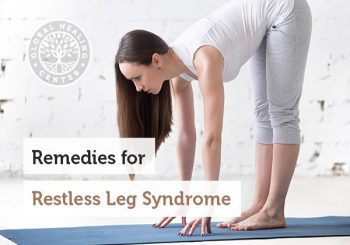Guest Writer for Wake Up World
Yikes, what is that? You are lying down in bed but there is a creeping, tingling, pulling sensation in your legs, which gives you a strong, uncontrollable urge to move your legs. In fact, it feels likes bugs are crawling on your legs. Goodbye, sleepytime.
Welcome to restless leg syndrome, also known as Willis-Ekbom disease.
It’s estimated that seven to ten percent of Americans experience restless leg syndrome. Fortunately, you are not destined to spend your life like you are performing on the Rockettes’ kickline.
Although restless leg syndrome is a neurological condition, many natural home remedies can help you calm that jumpy, let’s-go-for-a-jog-now feeling.
What Is Restless Leg Syndrome?
On average, 7 to 10 percent of Americans experience restless leg syndrome.
Doctors categorize restless leg syndrome as a sleep disorder since symptoms occur mainly at night and while sleeping. However, the sensations may also happen during the day — especially when you sit still for a long time, such as on a plane or car ride.
A chronic condition, restless leg syndrome (sometimes abbreviated as RLS) affects both women and men, but women more often. It can also occur in children, particularly ones with ADHD (attention deficit hyperactivity disorder). More severe symptoms usually occur in middle-aged or older individuals.[1]
While not life-threatening, it can make life unpleasant and also negatively affect your sleep. Without proper care, the condition can even cause depression and anxiety.[1]
Note that restless leg syndrome is not just when you occasionally get tingly legs, but when it occurs on a regular, frequent basis.
Restless leg syndrome can be a symptom of another disease, such as diabetes, or may appear for no known reason.[2] If you think you might have restless leg syndrome, see your healthcare provider to get an accurate diagnosis. Some other conditions such as anemia and arthritis have similar symptoms.
Top 11 Remedies for Restless Leg Syndrome
Researchers have found that certain natural home remedies really help improve symptoms, and — even better — generally have no side effects.[3]
1. Make Some Lifestyle Changes
Sometimes the simplest actions are the most effective in improving health concerns. With just a few tweaks, you can reduce your nightly can-can dance.
- If you take medications, review them with your physician to see if any trigger restless leg syndrome symptoms. Certain antidepressants and antihistamines can make symptoms worse. Your doctor can find substitutions.
- Quit smoking; cigarettes can trigger restless leg syndrome. If your partner smokes, have him or her smoke outside and avoid secondhand smoke.
- If you have to remain seated for a while, such as at work, on a plane, or while driving, take walking and stretching breaks. Alternatively, do stretches while seated. Rotate your ankles, kick your legs outward, or stretch your hamstrings.
- Wear loose clothing, especially while sleeping.
2. Exercise to Reduce That Jumpy Feeling
Exercise of any kind has long been the go-to for reducing restless leg syndrome symptoms. The main medication given to people with this syndrome has dopamine-boosting effects, and experts believe that exercise helps because it similarly boosts dopamine in the body — naturally.[4]
In one study, participants who performed aerobics and lower-body resistance training three times a week had significant improvement in symptoms.[5] If you’re interested in a custom fitness plan, a licensed physical therapist can help you devise an appropriate workout routine.
- Try for 30 to 60 minutes at a moderate level — daily is optimal.
- Even simple exercise like walking outside, or on a treadmill, can do wonders.
- Avoid intense, long-duration workouts because they may make symptoms worse.
- Work out earlier in the day, not within an hour or two of bedtime.
3. Get Some Rest
Insomnia or other sleep issues not only make restless leg syndrome symptoms worse, but they can also wreak havoc on your mood, concentration, and energy.[6]
You can’t sleep because you are flailing your legs all night, yet a restful night’s sleep will make the symptoms calm down! Here are some ways to calm your anxious legs at night and ensure you get the hours of slumber you need.
- Make your bedroom calming. Use soothing colors such as blues, greens, and lavenders. Ensure good airflow, a quiet room, no light, and a temperature set at 68 degrees or cooler.
- Sleep on cotton or linen sheets and wear pajamas that wick away sweat.
- Get off all electronic devices an hour before bedtime.[7, 8]
- Get plenty of sunshine in the morning and the late afternoon to set your circadian rhythm.
- Do not consume caffeine after lunch, and drink no more than one glass of alcohol at an early dinner. You might even try giving up both permanently.
- Stick to a pattern: Get up and go to bed around the same time every day and night.
- Meditate and do deep breathing exercises with the lights off when you first get into bed.
4. Get Out From Under the Stress Monster
Restless leg syndrome symptoms can go haywire when you are under stress. Fortunately, many techniques can help reduce tension and anxiety — and they’re good for your mental health. For example, controlled deep breathing, yoga, tai chi, and mindful meditation are all beneficial for daily stress. Several kinds of meditation that help include:
- Try Tai chi, which offers the double blessing of exercise and meditation.
- Practice mindfulness meditation.
- Do meditative walking: focus on your body, mind, and breath as you walk.
- For more ideas, check out Dr. Group’s Recommendations for Stress Management article.
Be honest with yourself and others about your limitations. Learn to say no to requests that will overload and complicate your life. Instead, make room for friends and family who make you feel good. Research has shown that the support of a good buddy lessens the impact of negative events.[9]
5. Try Vitamins & Supplements
Some supplements are known to provide help for people with restless leg syndrome. When you can’t get enough of these minerals and vitamins from food, you can get them from supplements.
Iron
The strongest risk factor for restless leg syndrome is insufficient iron in the diet.[10] Interestingly, experts have linked a lack of iron in the brain, rather than in the rest of the body, to restless leg syndrome — so regular blood tests may not reveal the iron insufficiency that may exist. It’s unclear how or why the brain does not get enough iron in people with restless leg syndrome.
Did you know that an iron deficiency is the strongest risk factor for RLS?
Taking an iron supplement may help normalize its levels for those who do not have enough, although healthcare experts may need to administer it intravenously for best results.[11, 12]
Vitamin D
Low vitamin D may exacerbate restless leg syndrome. One study reported that giving people vitamin D3 helped their legs feel better and less restless.[13]
Vitamin C and E
Experts believe that oxidative stress plays a role in the development of restless leg syndrome. That means that antioxidants, which counteract oxidative stress, may help. Studies have found that vitamin C, either taken alone or with vitamin E, may normalize symptoms.[14]
Magnesium
Periodic leg movements during sleep — with or without having restless leg syndrome — can reduce sleep quality and wake you up. Taking magnesium may help you sleep better by calming your nervous system.[15]
Folate and Folic Acid
Folate, one of the B vitamins (B-9 to be precise), is found in leafy green vegetables, mushrooms, and tomato juice. Folate occurs naturally, while you get its cousin molecule, folic acid, in supplements.
Some studies indicate folate may help your legs feel less jumpy.[16] Folic acid is not used efficiently in the body, and studies indicate that you should either get your B-9 from foods so you get the natural folate form; alternatively, take it with other B vitamins, which enhances its absorption.
Vitamin A and Beta-Carotene
Beta-carotene is a precursor of vitamin A, a red-orange substance that’s abundant in carrots. Both improve iron absorption in the body. Because iron plays such a key role in this condition, getting enough vitamin A in your diet can only help![17]
6. Practice Yoga and Simple Stretches
As an exercise, yoga can stretch out your restless legs, but can also generally improve your mood as well as your sleep quality. Yoga is also known to lessen stress in women. In one study, nine out of ten participants saw a noticeable change in how tingly their legs were within days of starting yoga.[18] Here are some tips:
- If you can’t find a good yoga studio near you, search for “gentle yoga stretches” on YouTube; try several until you find the one that works for you.
- Listen to your body — don’t push past what feels right.
- If yoga is not your thing, try simple leg stretches for relief.
7. Use Heat or Ice When You Have Symptoms
Some people with restless leg syndrome find their symptoms kick up in response to heat or cold. If you negatively react to one, applying the other may reduce symptoms.
- Try applying heat or ice packs to your legs.
- Take a warm or cool bath before bed. Add Epsom salts to the bath; they contain magnesium, which can work its way into your leg muscles.
8. Ease Poor Circulation With Massages
One theory is that poor circulation plays a role in restless leg syndrome. Massage can help blood get through congested areas, plus it promotes relaxation. Below are massage options for restless legs:
- Stroke. Use a relaxed, open hand to lightly stroke in a circular motion from your ankle upwards. Occasionally press into muscles.
- Press. Starting with your toes, pinch and press upwards, applying firm pressure on muscles and tendons. It should feel good; if it hurts, stop.
- Firm tapping. Using an open palm or light fist, lightly punch or knock on your legs from the bottom up.
If you can’t manage to massage yourself or don’t have a partner to help, buy an electronic massager that targets calf muscles, or have a steady date with a masseuse who understands the condition.
9. Eat a Healthy Diet
You can improve your symptoms by changing what you eat. We recommend a whole food, plant-based diet rich in organic fruits, vegetables, nuts, seeds, and other healthy foods. For restless leg syndrome, in particular, try to get more of the following into your meals.
- Foods with iron: spinach, legumes, dried apricots, potatoes, pumpkin, and sesame seeds.
- Foods with vitamin A and beta-carotene: carrots, sweet potatoes, spinach, kale, squash, red peppers, cantaloupe, apricots, oranges and orange juice, and peaches.
- Foods with vitamin C: citrus and dark leafy green vegetables.
- Foods with magnesium: avocado, nuts, flax, chia, pumpkin seeds, legumes, bananas, and leafy green vegetables such as kale and spinach.
- Avoid alcohol, refined sugar, and caffeine.
10. Try Aromatherapy to Relax
Research has found that essential oils can promote relaxation and sleep.[19] You can spray an oil-distilled water solution into the air or use a diffuser.
The following are good oils to use:
- Bergamot
- Cedarwood
- Lavender
- Roman chamomile
- Marjoram
- Sandalwood
- Vetiver
- Ylang-ylang
11. Keep a Symptom Diary
If you want to better understand what triggers your restless leg syndrome, and what helps, try using a journal or diary. Some questions to record:
- What time of day did symptoms occur?
- For how long did symptoms last?
- Did anything trigger symptoms, such as alcohol, caffeine, or nicotine?
- Do symptoms get worse after that late night snack or if you exercise hard right before bedtime?
- Do they get better if you take a bath?
- Do you get daytime attacks after sitting at the computer too long?
Share the diary with your doctor who may also pick up on some patterns.
What Causes Restless Leg Syndrome?
The causes of restless leg syndrome aren’t fully understood. Researchers believe they might be related to genetics and family history (especially if it begins before the age of 40), iron deficiency, or over-stimulation of the part of the brain that controls leg movement.[2] Some pregnant women experience it due to hormonal changes, but the symptoms usually go away after delivery.[20]
Restless leg syndrome can occur as a side effect of some drugs, such as certain antihistamines, selective serotonin reuptake inhibitors (SSRIs), tricyclic antidepressants, and antipsychotics.
Points to Remember
While the exact causes of restless leg syndrome aren’t yet known, you can control the condition, reduce your symptoms, and improve your sleep with natural remedies. Take inventory of your lifestyle — making some easy changes can make a world of difference.
Improve your sleep habits, exercise regularly and look for activities that will help you relax and reduce stress. Say hello to nice massages, essential oils, and baths! Keep a diary of your symptoms for your own information and to share with your healthcare provider.
Chow down on foods rich in folate, iron, magnesium, beta carotene, and vitamins A, C, D, and E. If you can’t get enough that way, take supplements regularly. May all your nights be kickless ones!
Have you tried any natural remedies for restless leg syndrome? What worked best for you? Share below!
References:
- Restless Legs Syndrome Fact Sheet. National Institute of Neurological Disorders and Strokes, National Institutes of Health. Updated 6 July 2018. Accessed 2 Feb 2019.
- Ferre S, et al. New insights into the neurobiology of Restless Legs Syndrome. Neuroscientist. 26 July 2018. [Epub ahead of print]
- Mitchell UH. Nondrug-related aspect of treating Ekbom disease, formerly known as restless legs syndrome. Neuropsychiatr Dis Treat. 2011;7:251–257.
- Youngstedt SD, Kline CE. Epidemiology of exercise and sleep. Sleep Biol Rhythms. 2006 Aug;4(3):215–221.
- Aukerman, MM, et al. Exercise and restless legs syndrome: a randomized controlled trial. J Am Board Fam Med. 2006 Sep-Oct;19(5):487-493.
- Zlatan K, et al. Sleepy anger: restricted sleep amplifies angry feelings, J Exp Psychol Gen. 2018 Oct 25. [Epub ahead of print]
- Annual sleep in America poll exploring connections with communications technology use and sleep [news release]. 7 March 2011. National Harbor, MD:National Sleep Foundation. Accessed 2 Feb 2019.
- Mure LS, et al. Sustained melanopsin photoresponse is supported by specific roles of ?-Arrestin 1 and 2 in deactivation and regeneration of photopigment. Cell. 2018 Nov 27;25(9):2497-2509.
- Adams RE, et al. The presence of a best friend buffers the effects of negative experiences. Dev Psychiatry. 2011 Nov;47(6):1786-1791. Accessed 2 Feb 2019.
- Causes of Restless Leg Syndrome. Johns Hopkins Medicine: Neurology and Neurosurgery. Accessed 2 Feb 2019.
- Allen RP, et al. Clinical efficacy and safety of IV ferric carboxymaltose (FCM) treatment of RLS: a multi-centred, placebo-controlled preliminary clinical trial. Sleep Med. 2011 Oct;12(9):906-913.
- Cho YW, et al. Clinical efficacy of ferric carboxymaltose treatment in patients with restless legs syndrome. Sleep Med. 2016 Sep;25:16-23. Accessed 2 Feb 2019.
- Wali S, et al. The effect of vitamin D supplements on the severity of restless legs syndrome. Sleep Breath. 2015 May;19(2):579-583.
- Sagheb MM, et al. Efficacy of vitamins C, E, and their combination for treatment of restless legs syndrome in hemodialysis patients: a randomized, double-blind, placebo-controlled trial. Sleep Med. 2012 May;13(5):542-545.
- Hornyak M, et al. Magnesium therapy for periodic leg movements-related insomnia and restless legs syndrome: an open pilot study. Sleep. 1998 Aug 1;21(5):501-5.
- Patrick LR. Restless legs syndrome: pathophysiology and the role of iron and folate. Alternative Medicine Review. 2007 Jun;12(2):101-112.
- Layrisse M, et al. New property of vitamin A and beta-carotene on human iron absorption: effect on phytate and polyphenols as inhibitors of iron absorption. Arch Latinoam Nutr. 2000 Sep;50(3):243-248.
- Innes KE, et al. Efficacy of an eight-week yoga intervention on symptoms of restless legs syndrome (RLS): a pilot study. J Altern Complement Med.2013 Jun;19(6):527-535.
- Hashemis SH, et al. The effect of massage with lavender oil on restless leg syndrome in hemodialysis patients: A randomized controlled trial. Nurs Midwifery Stud. 2015 Dec; 4(4):e29617.
- Weinstock LB, et al. Restless legs syndrome – theoretical roles of inflammatory and immune mechanisms. Sleep Med Rev. 2012;16(4):341-354.
Originally published at Global Healing Center and reproduced here with permission.
Recommended articles by Dr. Edward Group:
- What are Whole Foods and Why are They Important for Health?
- Top Vitamin C Benefits for the Skin
- Wim Hof Breathing: 6 Benefits for Body and Mind
- Camu Camu: The Next Great Superfood
- Emotional Freedom Technique (EFT): 5 Benefits and How To Do It
- Enokitake Mushrooms: 7 Benefits of this Superfood
- Here are 7 Reasons to Try a Cleanse
- 3 Scientifically Proven Ways Meditation Boosts Your Immune System
- What is Candida? Understanding Yeast Imbalance
- Acerola Cherry: 8 Benefits of this High-C Tropical Super Fruit
About the author:
Dr. Edward F. Group III (DC, ND, DACBN, DCBCN, DABFM) founded Global Healing Center in 1998 with the goal of providing the highest quality natural health information and products. He is world-renowned for his research on the root cause of disease. Under his leadership, Global Healing Center earned recognition as one of the largest natural and organic health resources in the world. Dr. Group is a veteran of the United States Army and has attended both Harvard and MIT business schools. He is a best-selling author and a frequent guest on radio and television programs, documentary films, and in major publications.
Dr. Group centers his philosophy around the understanding that the root cause of disease stems from the accumulation of toxins in the body and is exacerbated by daily exposure to a toxic living environment. He believes it is his personal mission to teach and promote philosophies that produce good health, a clean environment, and positive thinking. This, he believes, can restore happiness and love to the world.
For more, please visit Global Healing Center.

If you've ever found value in our articles, we'd greatly appreciate your support by purchasing Mindful Meditation Techniques for Kids - A Practical Guide for Adults to Empower Kids with the Gift of Inner Peace and Resilience for Life.
In the spirit of mindfulness, we encourage you to choose the paperback version. Delve into its pages away from screen glare and notifications, allowing yourself to fully immerse in the transformative practices within. The physical book enriches the learning process and serves as a tangible commitment to mindfulness, easily shared among family and friends.
Over the past few years, Wake Up World has faced significant online censorship, impacting our financial ability to stay online. Instead of soliciting donations, we're exploring win-win solutions with our readers to remain financially viable. Moving into book publishing, we hope to secure ongoing funds to continue our mission. With over 8,500 articles published in the past 13 years, we are committed to keeping our content free and accessible to everyone, without resorting to a paywall.








